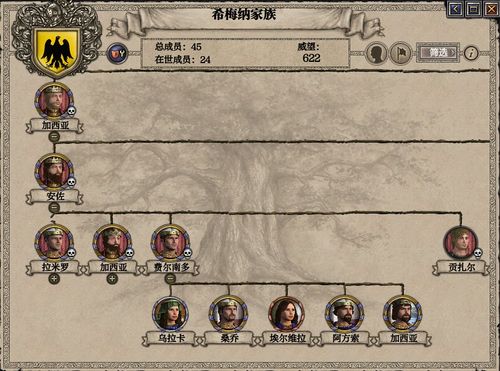Dynasties are either declared in the /common/dynasties/ folder or randomly created using the prefix defined for the culture.
Definition
The most basic dynasty definition requires a unique numeric ID, a name in the form of a string, and a Culture in the form of an alphanumeric ID which references the same ID in the cultures files. The culture line is used to determine if it will appear as a random name in the Ruler Designer, and it may be used for random characters of a culture.
Here's an example of a basic dynasty:
12345 = {
name = "Example"
culture = english
}
Coat of Arms
It's also possible to define a Coat of Arms for a dynasty.
Template
A Coat of Arms definition requires a template to be selected. There are five templates available to use in the CoA. Each of them uses a different number of layers, and we must create all of them to avoid the game crashing.
| ID | Name | Layers |
|---|---|---|
| 0 | Plain | 1 |
| 1 | Per Fess | 2 |
| 2 | Per Pale | 2 |
| 3 | Per Cross | 4 |
| 4 | Triangle | 3 |
Layers
A layer is defined as follows:
| Attribute | Description | Data Type | Example |
|---|---|---|---|
| texture | The pattern texture file ID to use. | Integer | texture = 0 |
| texture_internal | The ID of the pattern tile in the file to use | Integer | texture_internal = 4 |
| emblem | An optional tag setting the emblem ID to draw on the layer | Integer | emblem = 7 |
| color | Used one or more times to select which colors to use for drawing Not having enough colors defined will crash CK2 The number required is dependent on the selected pattern texture |
Integer | color = 3 |
Example
Here's an example of a dynasty definition with a Coat of Arms:
12345 = {
name = "Example"
culture = english
coat_of_arms = {
template = 1 # Per Fess, requires two layers
layer = {
texture = 0 # First pattern file, contains 27 tiles, each of two colours
texture_internal = 21 # The 22nd tile in the texture
emblem = 24 # The 25th of 25 emblems in vanilla CK2
color = 1 # The first colour, Argent
color = 2 # The second colour, Blue
}
layer = {
texture = 0 # First pattern file, contains 27 tiles, each of two colours
texture_internal = 5 # The 6th tile in the texture
color = 5 # The first colour, Black
color = 0 # The second colour, Gold
}
}
}
See also
| 历史 | 角色 • 家族 • 省份 • 头衔 • 剧本 |
| 脚本 | 指令 • 条件 • 作用域 • 修正 • 事件 • 决议 |
| 常规 | 定义 • 游戏规则 • 另类开局 • 宗教 • 文化 • 政体 • 特质 • 血脉 • 科技 • 法律 • 建筑 • 宣战理由 • 朝贡国 • 单位 • 目标 • 疾病 • 死亡 • 荣誉头衔 • 社团 • 宝物 • 地图外政权 • 内阁成员 • 贸易路线 • 继承 • 奇观 • 称号 |
| 图像/音效/本地化 | 地图 • 图形 • 盾徽 • 肖像 • 界面 • 小地图 • 音乐 • 本地化 |
| 其他 | 故障排除 • 验证器 • 控制台指令 • 编辑游戏存档 • Steam创意工坊 • EU4转档器模组制作 |
